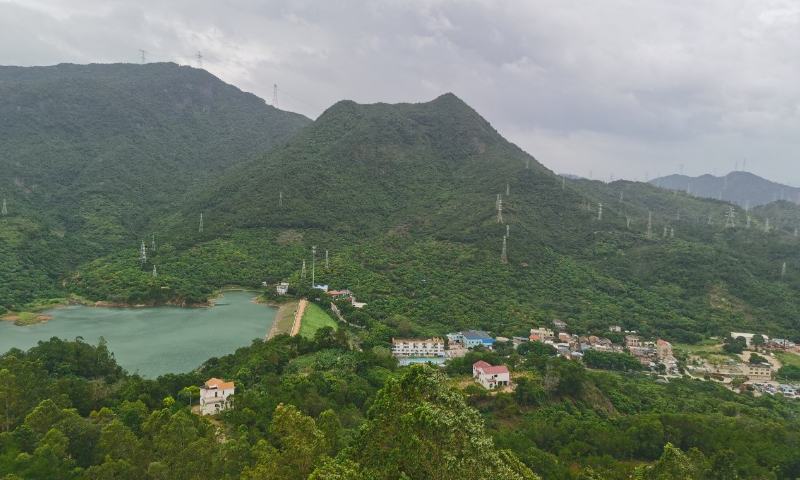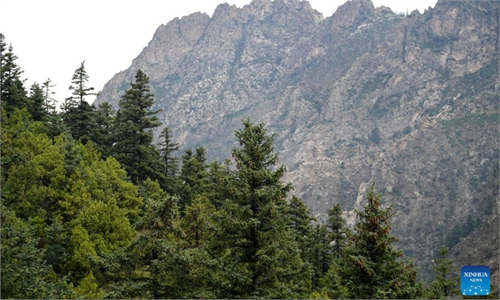IN-DEPTH / IN-DEPTH
Nature reserve born in 'world's factory' in the Greater Bay Area offers wisdom in the competition between the economy and nature

Views from the National Forest Park, Mount Guanyin Photo: Hu Yuwei/GT
Sustainability is the backbone of business, which has been proven to be more than accurate in the Guangdong-Hong Kong-Macao Greater Bay Area (GBA) that is expected to be built into a world-class city cluster with enhanced connectivity and improved ecodevelopment.
How to struck balance between economic growth and environmental sustainability has long been a common struggle for worldwide nature reserves. And in South China's Dongguan, also known as "the world's factory" due to its prosperous manufacturing industry, located in the hinterland center of the GBA, such difficulties and struggles are even more prominent.
It is hard to imagine that there is an urban "green lung" in "the world's factory." A visit to the National Forest Park of Mount Guanyin, the largest and most complete secondary forest in Dongguan on the border between Dongguan and Shenzhen, in Zhangmutou Town of Dongguan, revealed how it dealt with this contradiction to achieve an organic balance.
Here, entrepreneurial investment plays a much more important role in funding environmentally sustainable projects that help generate economic value for the whole region.
Mount Guanyin is located at the center of the GBA, with Hong Kong, Shenzhen, Dongguan, Guangzhou and other core cities all within a one-hour trip radius. Different from most nature reserves located in economically backward parts of China, Mount Guanyin is in the most economically developed area in the country. It faces the most intense contradiction and competition between economic growth and protection of the environment which is challenging and the benefits are both obvious.
China unveiled a development plan for the Guangdong-Hong Kong-Macao Greater Bay Area in February 2019, vowing to develop a quality space for living, working, and traveling by firmly adopting the people-centered development philosophy and putting into practice ecological conservation ideas for the building of a "beautiful bay area that is ecologically safe, environmentally attractive, socially stable and culturally vibrant."
Established in 2000, the National Forest Park of Mount Guanyin, the first such park to be developed by a private operator in China, achieved such results by turning a barren mountain full of weeds into a multifunctional park, integrating ecological sightseeing, physical activities, religious tourism, in a "natural oxygen bar," attracting visitors from the Bay area.

Views from the National Forest Park, Mount Guanyin Photo: Courtesy of National Forest Park of Mount Guanyin
Seeking balance from contradictions
A stroll through the forest park is a refreshing escape from the ever-humming, high-speed manufacturing engine, as one is surrounded by greenery, breathing in the fragrance of various shrubs and experiencing a century-old primeval forest that has largely preserved its ancient landscape.
The forest park has a vegetation coverage rate of more than 92 percent and has a total breeding population of nearly 1,000 species of wild plants and more than 300 species of wild animals.
It is reported that the park spends nearly 10 million yuan ($1.49 million) each year on forest improvement to protect rare plants such as the white Osmanthus and Camellia sinensis, and rare wild animals such as Chinese salamanders, pangolins, and wild boar herds.
On January 11, 2003, the park opened the world's first ancient tree museum, preserving and displaying trees up to 4000 years old, raising people's awareness of the ancient environment and paleoclimate.
With this investment, Mount Guanyin's forest coverage has increased from 60 percent in 2000 to more than 92 percent currently. Experts found that the park has rich negative oxygen ions, which greatly optimize the air quality of surrounding towns, and is an important ecological barrier for the province.
Since the mid-1980s, Dongguan has been China's leading export and manufacturing base, producing clothes, toys, and shoes. Research found that a harmful fine carcinogenic particulate PM2.5 had been increasing until around 2017.
While many factory workers in the past lived in a dorm in a condensed industrial district, remote from the city center, there is now a greener life beyond the factory walls amid local enhanced environmental measures.
But caring for the environment in the advanced machinery of the world's factory has never been a smooth road. For many, it was as if this had halted many people's money-making machine. Environmental protection was once regarded as a sector with a long way to go and a very low return on investment after the reform and opening-up.
In recent years, driven by economic interests, nearby villagers have used traps to hunt animals. The operator of the park has updated nearly 50 warning signs in the park since 2021 and has carried out 24-hour patrols to remove 16 hunting traps in a timely manner.
The operator does not allow overhead electronic power lines to cut through the jungle and destroy vegetation, preferring to generate electricity by other means at a higher cost.
"When our resolute protection of the environment conflicts with the desire of local villagers for economic development, we can only try to create more jobs to compensate and ease the conflict," Chen Jingyu, head of the Mount's management committee, told the Global Times.
Aiming to build the park as one of the demonstration areas for green development in the GBA, the head of Mount Guanyin's developer, Huang Ganbo, told the Global Times that they plan to further increase the share of the health and fitness economy in the park and make it a leading force driving local economic development.

People visit the National Forest Park, Mount Guanyin. Photo: Courtesy of National Forest Park of Mount Guanyin
Multi-functional themed green hub
On December 28, 2009, Mount Guanyin was categorized as a 4A level tourist site by the National Tourism Administration. It was also added to the International Eco-Safety Cooperative Organization of the United Nations' list of the model foundation of international ecological travel in China in October 2006.
In the past few years, Mount Guanyin has launched various health and culture activities, such as New Year's climbing events, Greater Bay hiking festivals, summer night music camping festivals, and even large-scaled "blind date" events that attract people from the Greater Bay metropolitan areas.
The green ecological space in the cities of the Greater Bay Area is very limited and there are few high-quality forest park resources. Mount Guanyin has thus become a popular destination for Hong Kong tourists, given its convenient transportation and shared belief in Buddhism, Chen told the Global Times.
Mount Guanyin has received more than 15 million tourists from home and abroad up to now making a direct tourism income of more than 1.5 billion yuan ($223.8 million), and directly and indirectly helped nearly 20,000 people to find jobs in relevant industries, as it has successfully explored a new path of symbiosis between ecological protection and economic development in the GBA.
Huang said that, in line with the ecological development plan of the GBA, Mount Guanyin will invest more in ecological construction and protection, take good care of natural wealth and strive to create a "green bank" for sustainable development for future generations.
It took 22 years to transform the site, from a barren mountain to a popular tourist destination in the GBA. The shining green pearl of the "world factory" is showing its vitality.


